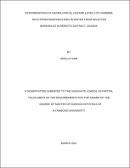| dc.contributor.author | Okello, Sam | |
| dc.date.accessioned | 2022-02-09T13:50:04Z | |
| dc.date.available | 2022-02-09T13:50:04Z | |
| dc.date.issued | 2021-03 | |
| dc.identifier.citation | Okello, Sam (2021) Determination of radiological hazard levels of gammma rays from radionuclides in water from selected Boreholes in Moroto district, Uganda. | en_US |
| dc.identifier.uri | https://kyuspace.kyu.ac.ug/xmlui/handle/20.500.12504/457 | |
| dc.description | x,89 p.: ill (somecol) | en_US |
| dc.description.abstract | This study was designed to identify gamma ray emitting radionuclides using the GDM 20 NaI(Tl) detector and to determine and compare the activity concentrations, absorbed dose rates, annual effective dose equivalent and the internal and external radiological hazard levels of gamma rays from radionuclides in water from boreholes in four sub counties of Rupa, Katikekile, Nadunget and Northern Division of Moroto District.
The radionuclides of 226Ra and 232Th were found in water samples from all the boreholes of the four sub counties. The radionuclide of 40K was only found in two boreholes, three boreholes and five boreholes of Rupa, Katikekile and Nadunget respectively. None was found in the boreholes from Northern Division. The activity concentration of 226Ra exceeded the world average value of 35 Bql-1 in three boreholes of Rupa and Northern Division; in four boreholes of Katikekile and in all the seven boreholes of Nadunget. The activity concentration of 232Th was found to be less than the world average of 30 Bql-1 in all the water samples from all the regions. The activity concentration of 40K was found to exceed the world average of 400 Bql-1 in all the water samples from all the regions. The absorbed dose rates was found to be greater than the world average of 84 nGyh-1 for water samples from two boreholes of Rupa and Northern Division; in five boreholes of Katikekile and in six boreholes of Nadunget. The annual effective dose equivalent was found to be lower than the world internal exposure limit of 0.41 mSvy-1 in all the water samples analyzed. The internal radiological hazard level was found to exceed the permissible value of 1.00 (unity) only in one borehole and three boreholes in Katikekile and Nadunget respectively. The external radiological hazard level was found to exceeded the permissible limit in one borehole from Nadunget; and equal to 1.00 the permissible limit in one borehole from Katikekile.
However activity concentration of 226Ra and 40K exceeded the world average value in seventeen boreholes and ten boreholes respectively. While 232Th activity concentrations in all boreholes were below the world average value. It is recommended that a similar study should be carried out to check the results of this study and to find the excess life time cancer risk on the populace that use the water especially those that show high activity and hazard levels. The scope of the study for later studies should be extended to more boreholes. | en_US |
| dc.language.iso | en | en_US |
| dc.publisher | Kyambogo University | en_US |
| dc.subject | Radiological hazard levels | en_US |
| dc.subject | Gammma rays | en_US |
| dc.subject | Radionuclides | en_US |
| dc.subject | Boreholes | en_US |
| dc.subject | Moroto district | en_US |
| dc.subject | Uganda | en_US |
| dc.title | Determination of radiological hazard levels of gammma rays from radionuclides in water from selected boreholes in Moroto district, Uganda | en_US |
| dc.type | Thesis | en_US |

